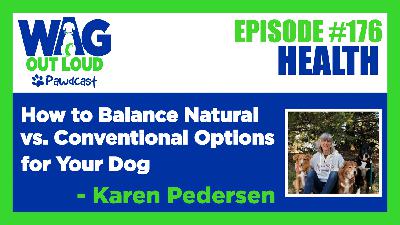Silent Pain - The Problem 53% of Pet Parents Miss!
Update: 2023-06-21
Description
Hello there this is Krista with Episode #178 on the Wag Out Loud pawdcast. Think about this. The sound frequencies that are produced during storms can actually be painful to your dog's ears. And the static electricity that accumulates in their fur due to any change of pressure can also be really unpleasant for them. So if your dog freaks out during storms, they're not just unsure of what's happening, but they may be experiencing a painful physical reaction as well.
Welcome to the Wag Out Loud pawdcast, where we are obsessed with bringing you helpful tips on canine health care, nutrition, and overall wellbeing. If you'd like to support the show, check out the amazing online events, products and resources that I personally recommend on the Wag Out Loud website. I'm your host, Krista and I'm super excited to be bringing you yet another tail wagging episode.
Dr. Edward Bassingthwaighte is known globally as The Healing Vet. Through his own recovery from Chronic Fatigue Syndrome/Lyme, he explored holistic medicine and energy healing. He is the founder of a profoundly healing bodywork modality for pets, people and horses - the Whole Energy Body Balance™ Method.
Hello, dog lovers, thank you so much for being here today. I am so honored to have Dr. Edward Bassingthwaighte on the show. And he's going to talk about Silent Pain, which is a problem that 53% of pet parents actually miss. And I learned about Dr. Edward, probably three or four months ago, I think he was a guest on the Dog Gone Calm Club with Lisa Spector. And I was just so fascinated about his work and just had to have him on the Show. So Dr. Edward, thank you so much for being with us today.
You're welcome. It's a pleasure to be here. And it's really exciting to be able to share this information about Silent Pain because it's something that's really not known in the veterinary industry. And then of course, the general public have little or no idea about it too.
Well, I'm happy to share it with all of our listeners today. So why don't we start with you introducing yourself and why are you known as the healing vet?
Well, probably because I thought it was pretty cool brand name.
It is a cool brand name.
Because that brand name really is the essence of of what I'm about which is not only working one on one with people to help them give their animals the best possible life when it comes to holistic health care and vitality and, and longevity but also empowering pet parents to take their pets’ wellbeing into their own two hands. So I'm I'm deeply involved in online education in teaching people how to understand what holistic healthcare is how to implement it. And also I'm the creator of the Whole Energy Body Balance method, which is a profoundly healing, neuro fascial body work and energy work modality for pets, people and horses that are available for everyday people who want to be home practitioners and for for pet wellness professionals who want to be certified.
Well, you've got so many great courses, you're helping so many people and animals. Why don't we talk about I know, especially with dogs, that if they have pain, they most of the time like to hide it. So when they actually show signs of pain, isn't it that it's pretty advanced when we can see that they're in pain?
How to Notice That Your Dog is in Silent Pain
Well, yes and no, I think probably a good place to start is to talk about the difference between acute pain and chronic pain. Acute Pain is usually an injury to one part of the body, there's usually an abrupt increase in pain. And acute pain is super easy to see. There's a rapid change in the animal. There's obvious symptoms like a lameness or a sudden change in behavior becoming withdrawn, obviously unhappy, that sort of thing. So then that gives a lot of people a false sense of security that they are always going to be able to see any kind of pain in their animals, but unfortunately, chronic pain often develops slowly so that any changes if they happen are outside the ability of the human to see them. And another thing about chronic pain, soft tissue pain in particular, which is the most common cause of silent pain that I see is that it's often throughout the whole body. So therefore, there's no one part of the body like with a sore foot, you'll get a lameness. It's easy to see if you've got a dog with gastroenteritis, you'll get vomiting or diarrhea. And these symptoms are very specific to the problem so they're easy to see and pick up whereas chronic pain, chronic soft tissue pain in particular, what happens is that you get animals that might have a gradual change over months or even years. Maybe they get a little slower and stiffer and people just think oh, wow, you know, they're just old. That's normal. Shouldn't we don't need to worry about it? Whereas in reality, you can have animals with incredible levels of pain, chronic pain that they're existing with, but it's sucking a lot of the joy and, and life and connection out of their experience of, of living in relationship with their humans.
Yeah. Well, how did you come to realize that the statistic is 53% of our dogs are living in pain?
So some years ago, I missed really awful neck pain in my own little dog. That triggered me into getting curious about how many other people might be missing silent pain in their pets. And what I did was I did a small informal clinical study where I had 63 People come in the door with new dogs that I’d never seen before. And before I looked at their dogs and examined their dogs, I asked them, you know, do you think your dog has got any pain? And 53% of them said no, but when I got my hands on the dogs, the dogs had significant, really significant pain going on in their, in their body, soft tissue, chronic pain.
And how long ago was this realization for you?
Well, I realized a long time ago that there was a lot of undiagnosed neck and back pain. It's probably about 26 years ago, when I, I ran into another vet who worked with horses necks. He would take horses that had a falling lameness that they could not find a reason for, with no blocks, X rays, or that sort of thing. He'd released the vertebrae in the neck and the lameness would go away. So that was from nerve root compression. Now, that was all news to me, because I've never been taught a thing about that at university. So my next thought was, well, what about dogs and cats? They have necks and backs. So I started, you know, feeling with deeper into the body and with with more curiosity about what might be going on through the neck and spine. And pretty quickly, I started finding a whole lot of pain, tension, dysfunction, that before I started exploring more deeply into the body, I was missing. Now that's developed over the years, then I realized that there's the soft tissue, the neuro fascial tissues, throughout the body, store and hold pain and trauma. And they're also involved in anxiety and stuff like that. So it's been a kind of an evolution, but it's only about six or seven years ago, maybe eight years ago that I missed really awful neck pain in my own dog. And that's when I realized that, you know, I thought like a lot of people probably listening to this show right now probably think that they can that their pets will tell them when they have pain. And you know, I had probably a bit of veterinary arrogance running. I know veterinarians are a little bit prior to that kind of thing. But I thought I could look at my dog and tell when he had pain. Turns out, he had a very, very painful neck. He had a fall on the steps, which my wife actually saw, but he got up, shook himself off and seemed okay, so she didn't think to tell me, then a small change in behavior three weeks later, made me get my hands on him. And I found that he was in agony, but he was still not showing any signs to even my highly trained eyes.
Wow. So this soft tissue pain that you're talking about? What is the average age that in your mind, dogs start to suffer the silent pain?
When Do Most Dogs Start Feeling Pain?
Look, it can vary. Most dogs by the time they get somewhere to between five to eight years of age, you're going to have built up a significant amount of soft tissue pain. But at the moment, I'm working with an 18 week old when I first saw it, it's an 18 week old puppy. Rhodesian Ridgeback puppy who's already got incredible amounts of pain in his body. Now, whether that's from some kind of birth injury or some kind of puppy accident or whatever. So you just don't know even younger dogs can if they've had a bad crash when they're little puppies and crying, like playing like a mad thing can have a legacy of silent pain. I've seen a lot of dogs that after you know the routine, normal desexing operations are left with a legacy of soft tissue pain. You know, male dogs in the groin area, female dogs through the abdominal cavity. So there's a lot of different things that can can leave that kind of history or legacy and that gets locked up in the soft tissue in the neuro fascial network in the animal's body.
Well, why don't we break this down more? Because you say that silent pain is made up of three different areas. So there's physical, there's anxiety, and there's trauma? Can you unpack each of those?
Three Areas of Silent Pain
Well, physical pain is soft tissue pain that is in the soft tissues of the body now, particularly in what I call the neuro fascial network, which is the connective tissues of the body. And the connective tissues of the body have very high concentrations of nervous tissue in them. Especially a lot of sensory awareness. So the fascia is everywhere in the body. It is the scaffolding or structure of every other organ in the body on every scale of dimension. If you look at an x ray, you'll never see soft tissue pain on an x ray, it doesn't show up on imaging, which is another reason why I believe vets miss it. I mean, vet's have a knowledge and skills gap when it comes to feeling into
Welcome to the Wag Out Loud pawdcast, where we are obsessed with bringing you helpful tips on canine health care, nutrition, and overall wellbeing. If you'd like to support the show, check out the amazing online events, products and resources that I personally recommend on the Wag Out Loud website. I'm your host, Krista and I'm super excited to be bringing you yet another tail wagging episode.
Dr. Edward Bassingthwaighte is known globally as The Healing Vet. Through his own recovery from Chronic Fatigue Syndrome/Lyme, he explored holistic medicine and energy healing. He is the founder of a profoundly healing bodywork modality for pets, people and horses - the Whole Energy Body Balance™ Method.
Hello, dog lovers, thank you so much for being here today. I am so honored to have Dr. Edward Bassingthwaighte on the show. And he's going to talk about Silent Pain, which is a problem that 53% of pet parents actually miss. And I learned about Dr. Edward, probably three or four months ago, I think he was a guest on the Dog Gone Calm Club with Lisa Spector. And I was just so fascinated about his work and just had to have him on the Show. So Dr. Edward, thank you so much for being with us today.
You're welcome. It's a pleasure to be here. And it's really exciting to be able to share this information about Silent Pain because it's something that's really not known in the veterinary industry. And then of course, the general public have little or no idea about it too.
Well, I'm happy to share it with all of our listeners today. So why don't we start with you introducing yourself and why are you known as the healing vet?
Well, probably because I thought it was pretty cool brand name.
It is a cool brand name.
Because that brand name really is the essence of of what I'm about which is not only working one on one with people to help them give their animals the best possible life when it comes to holistic health care and vitality and, and longevity but also empowering pet parents to take their pets’ wellbeing into their own two hands. So I'm I'm deeply involved in online education in teaching people how to understand what holistic healthcare is how to implement it. And also I'm the creator of the Whole Energy Body Balance method, which is a profoundly healing, neuro fascial body work and energy work modality for pets, people and horses that are available for everyday people who want to be home practitioners and for for pet wellness professionals who want to be certified.
Well, you've got so many great courses, you're helping so many people and animals. Why don't we talk about I know, especially with dogs, that if they have pain, they most of the time like to hide it. So when they actually show signs of pain, isn't it that it's pretty advanced when we can see that they're in pain?
How to Notice That Your Dog is in Silent Pain
Well, yes and no, I think probably a good place to start is to talk about the difference between acute pain and chronic pain. Acute Pain is usually an injury to one part of the body, there's usually an abrupt increase in pain. And acute pain is super easy to see. There's a rapid change in the animal. There's obvious symptoms like a lameness or a sudden change in behavior becoming withdrawn, obviously unhappy, that sort of thing. So then that gives a lot of people a false sense of security that they are always going to be able to see any kind of pain in their animals, but unfortunately, chronic pain often develops slowly so that any changes if they happen are outside the ability of the human to see them. And another thing about chronic pain, soft tissue pain in particular, which is the most common cause of silent pain that I see is that it's often throughout the whole body. So therefore, there's no one part of the body like with a sore foot, you'll get a lameness. It's easy to see if you've got a dog with gastroenteritis, you'll get vomiting or diarrhea. And these symptoms are very specific to the problem so they're easy to see and pick up whereas chronic pain, chronic soft tissue pain in particular, what happens is that you get animals that might have a gradual change over months or even years. Maybe they get a little slower and stiffer and people just think oh, wow, you know, they're just old. That's normal. Shouldn't we don't need to worry about it? Whereas in reality, you can have animals with incredible levels of pain, chronic pain that they're existing with, but it's sucking a lot of the joy and, and life and connection out of their experience of, of living in relationship with their humans.
Yeah. Well, how did you come to realize that the statistic is 53% of our dogs are living in pain?
So some years ago, I missed really awful neck pain in my own little dog. That triggered me into getting curious about how many other people might be missing silent pain in their pets. And what I did was I did a small informal clinical study where I had 63 People come in the door with new dogs that I’d never seen before. And before I looked at their dogs and examined their dogs, I asked them, you know, do you think your dog has got any pain? And 53% of them said no, but when I got my hands on the dogs, the dogs had significant, really significant pain going on in their, in their body, soft tissue, chronic pain.
And how long ago was this realization for you?
Well, I realized a long time ago that there was a lot of undiagnosed neck and back pain. It's probably about 26 years ago, when I, I ran into another vet who worked with horses necks. He would take horses that had a falling lameness that they could not find a reason for, with no blocks, X rays, or that sort of thing. He'd released the vertebrae in the neck and the lameness would go away. So that was from nerve root compression. Now, that was all news to me, because I've never been taught a thing about that at university. So my next thought was, well, what about dogs and cats? They have necks and backs. So I started, you know, feeling with deeper into the body and with with more curiosity about what might be going on through the neck and spine. And pretty quickly, I started finding a whole lot of pain, tension, dysfunction, that before I started exploring more deeply into the body, I was missing. Now that's developed over the years, then I realized that there's the soft tissue, the neuro fascial tissues, throughout the body, store and hold pain and trauma. And they're also involved in anxiety and stuff like that. So it's been a kind of an evolution, but it's only about six or seven years ago, maybe eight years ago that I missed really awful neck pain in my own dog. And that's when I realized that, you know, I thought like a lot of people probably listening to this show right now probably think that they can that their pets will tell them when they have pain. And you know, I had probably a bit of veterinary arrogance running. I know veterinarians are a little bit prior to that kind of thing. But I thought I could look at my dog and tell when he had pain. Turns out, he had a very, very painful neck. He had a fall on the steps, which my wife actually saw, but he got up, shook himself off and seemed okay, so she didn't think to tell me, then a small change in behavior three weeks later, made me get my hands on him. And I found that he was in agony, but he was still not showing any signs to even my highly trained eyes.
Wow. So this soft tissue pain that you're talking about? What is the average age that in your mind, dogs start to suffer the silent pain?
When Do Most Dogs Start Feeling Pain?
Look, it can vary. Most dogs by the time they get somewhere to between five to eight years of age, you're going to have built up a significant amount of soft tissue pain. But at the moment, I'm working with an 18 week old when I first saw it, it's an 18 week old puppy. Rhodesian Ridgeback puppy who's already got incredible amounts of pain in his body. Now, whether that's from some kind of birth injury or some kind of puppy accident or whatever. So you just don't know even younger dogs can if they've had a bad crash when they're little puppies and crying, like playing like a mad thing can have a legacy of silent pain. I've seen a lot of dogs that after you know the routine, normal desexing operations are left with a legacy of soft tissue pain. You know, male dogs in the groin area, female dogs through the abdominal cavity. So there's a lot of different things that can can leave that kind of history or legacy and that gets locked up in the soft tissue in the neuro fascial network in the animal's body.
Well, why don't we break this down more? Because you say that silent pain is made up of three different areas. So there's physical, there's anxiety, and there's trauma? Can you unpack each of those?
Three Areas of Silent Pain
Well, physical pain is soft tissue pain that is in the soft tissues of the body now, particularly in what I call the neuro fascial network, which is the connective tissues of the body. And the connective tissues of the body have very high concentrations of nervous tissue in them. Especially a lot of sensory awareness. So the fascia is everywhere in the body. It is the scaffolding or structure of every other organ in the body on every scale of dimension. If you look at an x ray, you'll never see soft tissue pain on an x ray, it doesn't show up on imaging, which is another reason why I believe vets miss it. I mean, vet's have a knowledge and skills gap when it comes to feeling into
Comments
In Channel
























